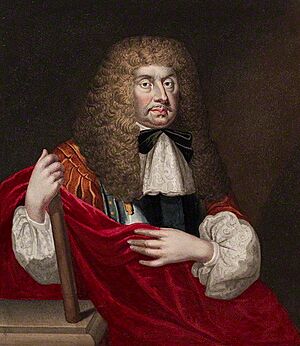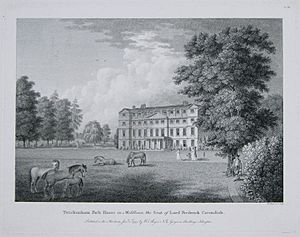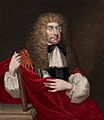John Berkeley, 1st Baron Berkeley of Stratton facts for kids
John Berkeley, 1st Baron Berkeley of Stratton (born 1602 – died 1678) was an important English soldier, politician, and diplomat. He lived at Berkeley House in Westminster and Twickenham Park in Middlesex. He was part of the Berkeley family, known for their history.
From 1648, he became a close friend and helper to James, Duke of York, who later became King James II. This friendship helped him become very famous and wealthy. John Berkeley and Sir George Carteret were the people who started the Province of New Jersey, which was a British colony in North America. Today, it is the U.S. state of New Jersey. His title, "Baron Berkeley of Stratton," comes from his important role in the Battle of Stratton in 1643. In this battle, the Royalist army, also called the Cavaliers, won a big victory against the Parliament's army, known as the Roundheads, in Devon and Cornwall.
Contents
John Berkeley's Family Background
John Berkeley was the second son of Sir Maurice Berkeley. His father was from Bruton Abbey in Somerset and was a member of a wealthy land-owning family. Sir Maurice was also a Member of Parliament, which means he helped make laws for the country. John's mother was Elizabeth Killigrew.
John's older brother was Charles Berkeley, 2nd Viscount Fitzhardinge. His younger brother, Sir William Berkeley, became the royal governor of the Colony of Virginia in America. He served there from 1642 to 1652 and again from 1660 to 1677.
Early Career and Adventures
In January 1637, John Berkeley was sent as an ambassador by Charles I of England to Christina of Sweden. His job was to suggest that England and Sweden work together. They wanted to help a German ruler, called the Elector Palatine, get his lands back. Berkeley returned from Sweden in July 1637.
He joined the army in 1638 to fight against the Scots and was made a knight in Berwick that same year. In 1640, he was chosen to be a Member of Parliament for two places, Heytesbury and Reading, but he chose to represent Heytesbury.
Fighting in the English Civil War
John Berkeley played a very important part in the First English Civil War. He strongly supported the king, who was King Charles I. He became the governor of Exeter and the general of the king's forces in Devon.
In 1642, he joined the Marquess of Hertford at Sherborne. He was sent to Cornwall to work under Sir Ralph Hopton. In May 1643, the king's forces won a big victory against the Earl of Stamford at the Battle of Stratton. They captured many supplies and cannons. After this, Sir John became the main commander of all the king's forces in Devon.
He then surrounded Exeter, where the Earl of Stamford had gone. The city was also protected by a fleet of ships led by Robert Rich, 2nd Earl of Warwick. Berkeley managed to keep the city surrounded, even fighting off the Earl of Warwick's ships. On September 4, 1643, the Earl of Stamford had to give up Exeter.
In 1644, Berkeley was at the baptism of the king's daughter, Henrietta Maria, who was born in Exeter. Later that year, Hopton and Berkeley joined their armies to stop Sir William Waller from moving west. However, they were badly defeated at the Battle of Cheriton in Hampshire on March 29.
In April 1645, he took over from Sir Richard Grenville. He became the main commander for Devon and Cornwall. He captured Wellington House near Taunton and then began to surround Taunton. But then, Thomas Fairfax moved his army west, which changed everything. In January 1646, Fairfax focused on Exeter, and Berkeley was forced to surrender the city on April 13, but he got good terms for his soldiers.
Helping the King Escape
After the king's forces lost the war, Berkeley joined his relative, Lord Jermyn, who was with Queen Henrietta Maria. Berkeley convinced the queen that he had friends among the army officers. He got a letter from her to the king.
He met with the king and tried to help him make peace with important army leaders like Oliver Cromwell and Henry Ireton. John Ashburnham also helped him. In July 1647, the army leaders offered the king a way to make peace, but the king refused it.
Berkeley was ordered by the king to help him escape from Hampton Court on the night of November 10, 1647. They traveled towards Hampshire and reached Lymington. Berkeley crossed the water to the Isle of Wight to talk to Robert Hammond, who was the Parliament's governor there. The Isle of Wight was where the king wanted to go. Hammond was not clear about what he would do. Berkeley and Ashburnham then brought Hammond to the king at Lymington. This decision was later criticized. King Charles felt he had no choice but to go with Hammond to Carisbrooke Castle. After this, Berkeley went back to London, still trying to use his influence with the army. But the officers treated him badly, and Parliament called him a "delinquent" (someone who had supported the king against Parliament). So, he returned to Paris.
Life in Exile
In Paris, Berkeley became the temporary governor for the Duke of York (the future King James II) in 1648. When the previous governor died in 1652, Berkeley took over the job permanently. He managed the Duke's money and tried to arrange a marriage between the Duke and Marie de Longueville, but the French court did not agree. Berkeley himself tried to marry Anne Villiers, Countess of Morton, who became a widow in 1651, but she turned him down. This led to a disagreement between Berkeley and Sir Edward Hyde.
Between 1652 and 1655, Berkeley served in the army under Turenne in Flanders. He went with the Duke of York as a volunteer. When the Duke decided to join Spain's army and moved to the Netherlands in 1656, Berkeley was still with him. In 1658, at the Duke's request, Berkeley was given the title of Baron Berkeley "of Stratton in Cornwall." This title was given to him in Brussels on May 19, 1658.
After the King Returned to Power
When the king was restored to power in England (the English Restoration), Berkeley joined the Admiralty, which managed the navy. In 1661, he was made Lord President of Connaught for life, which was an important job in Ireland. In 1663, Berkeley became a member of the Privy Council, a group of advisors to the king. The next year, he was made one of the Masters of Ordinance, dealing with military supplies. In January 1665, he joined the Committee of Tangier.
In 1670, he went to Ireland as the Lord Lieutenant, which was like a governor. He held this job for two years. He was seen as being friendly to Catholics. In December 1675, Berkeley was chosen to be an ambassador for England at the Congress of Nijmegen, a big meeting to discuss peace. However, he was not well and had to return home in May 1677 before the meeting finished.
Starting New Jersey
Because John Berkeley had a close relationship with King Charles II and the Duke of York, he was given land in New Jersey. He had already received land in Carolina. From 1664 to 1674, Berkeley was a co-owner of New Jersey.
In 1665, Berkeley and Sir George Carteret wrote a document called the Concession and Agreement. This document set up the rules for how the government of the Province of New Jersey would work. It also said that people in the colony would have freedom of religion.
Berkeley later sold his part of New Jersey to a group of Quakers. This happened because of problems with the Governor of New York, Richard Nicolls, and also with Carteret. This sale effectively split New Jersey into two colonies: East Jersey, which belonged to Carteret, and West Jersey. This division lasted until 1702. At that time, West Jersey had financial problems, so the Crown (the king's government) took back control and later joined the two colonies back together.
Berkeley's Homes
In 1665, John Berkeley started building Berkeley House. This was his very grand London home, built in the Italian style, located on the north side of Piccadilly near St James's Palace in Westminster. It cost almost £30,000 and was finished around 1673, after Berkeley returned from Ireland. The large area around the house, which is now in Mayfair in Central London, is remembered by street names like Bruton Street, Bruton Place, Bruton Lane, Stratton Street, Berkeley Street, and Berkeley Square.
Berkeley House was later bought by William Cavendish, 1st Duke of Devonshire in 1697 and was renamed Devonshire House. It sadly burned down in 1733 and was replaced by a new Devonshire House. In 1668, Berkeley also bought Twickenham Park in Middlesex, which was close to London.
Death and What He Left Behind
John Berkeley died on August 26, 1678, when he was 72 years old. He was buried on September 5 in St Mary's Church in Twickenham. There is a special window in the church that remembers him and his brother, Sir William Berkeley.
John Berkeley held many important jobs. Some people at the time, like Samuel Pepys, described him as a "fortunate" man, but also someone who could be "fiery" and "passionate" when talking.
Family Life
John Berkeley married Christian or Christiana Riccard. She was the daughter of Sir Andrew Riccard, who was a very rich merchant from London and worked for the East India Company. Christian had been married twice before.
John Berkeley had three sons, and each of them became Baron Berkeley of Stratton after him. He also had one daughter, Anne, who married Sir Dudley Cullum. The title of Baron Berkeley of Stratton ended in 1773 when the last son died without children.
Images for kids





